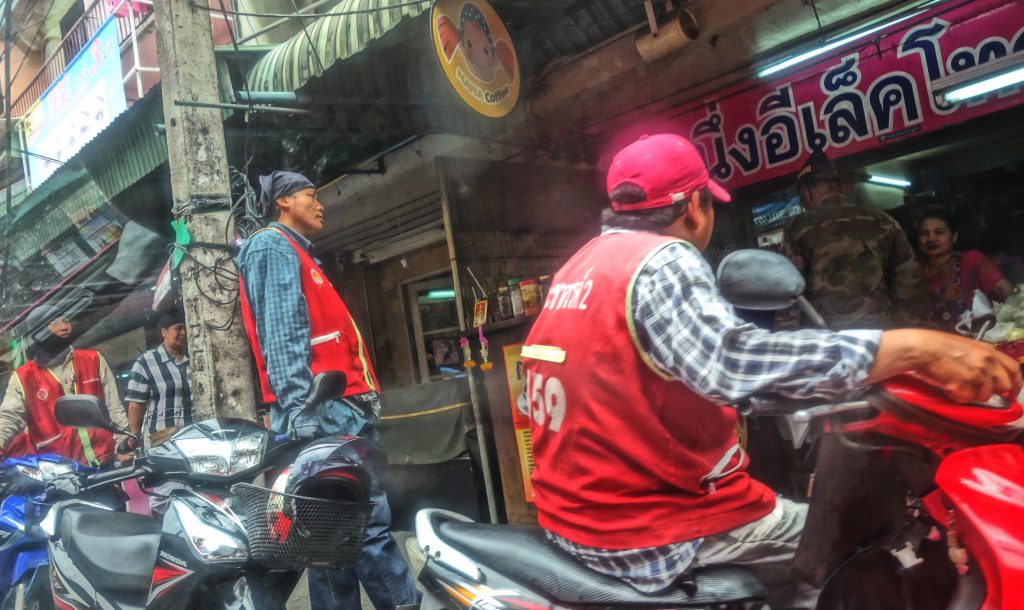On-demand food delivery apps are booming in Thailand, where consumption patterns offer a readily fertile market. In pre-COVID Thailand, approximately a third of all household expenses went towards food and beverage. Of these expenses, households spent almost half on ready-made food (cooked meals consumed at home). Expenditure on ready-made food is particular high in urban regions and major cities such as Bangkok, Chiang Mai, Chonburi and Pattaya.
Given that Thai households already spend substantially on takeaway food, the appeal of on-demand food delivery apps is obvious. Apps such as LINE, Grab, Food Panda and Get offer users a unified platform to order food from a variety of restaurants ranging from large global franchises to street-side stalls. Taxi-turned-delivery service Grab reported that its app facilitated 3 million meal deliveries across 16 provinces in January 2019 alone. Each of these deliveries was made by a contractless rider (most deliver orders by motorbike) who accepts the job or “gig” via the same app and is paid per trip. Movement restrictions during the pandemic have likely only boosted demand for food delivery.
As consumers increasingly turn to digital platforms to buy food, it’s worth asking how platform-mediated work is affecting labor standards and worker welfare in Thailand. In 2019, we interviewed riders as part of an upcoming report by the Just Economy and Labor Institute on platform-mediated work in Thailand. For riders, a novel aspect of gig work is the replacement of a human supervisor with a digital application. Platforms allocate and distribute work to riders through opaque and mysterious algorithms. While the algorithms used by apps differ and are a source of speculation, they subject riders to a “self-disciplining” effect, incentivising them to work harder, longer and faster—sometimes at the expense of their safety and rights.
Thailand’s gig economy
Platform-mediated work is a rapidly expanding form of informal work. Informal work is characterised by unregistered or non-permanent employment where workers do not receive benefits under the social security system. 28% of employment in Bangkok and more than 56% of employment across the country is of this nature. On-demand food delivery apps promote informal or precarious work because most workers are paid a piece-rate fee for each delivery, with no guarantee of steady work. Applications to deliver for food delivery apps in Thailand are simpler than recruitment processes for traditional employers. They are completed online, require few proofs of identity, and may take only 1-2 days to process.
It is difficult to present clear and accurate numbers on labor conditions in the gig economy, because food-delivery apps are not regulated by the government. No agency is responsible for collecting data on the number of workers they employ, wages or market share. In 2019, the average wage in Thailand’s broader transportation industry was approximately 18,000 baht per month. We estimate by comparison that platform-based food delivery riders earn between 15,000 to 40,000 baht per month. Income fluctuates depending on hours worked. From interviews with riders, however, we found that most riders have to work hours longer than typical full-time jobs to make earnings on the higher end of the spectrum.
Incomes from food delivery are not secure and these is reason to believe that they are on the decline. When food delivery apps first arrived in Thailand, many recruited riders through lucrative schemes. One platform, for example, offered a guaranteed income of 500 baht for new riders. Any rider who earned less than 500 baht after completing 10 deliveries earned a top-up. However, we have already begun to see major platforms in Thailand reducing delivery fees and incentives, a trend observed in other countries such as China. Riders have mobilised to protest falling delivery fees in a score of provinces across Thailand. Some argue that their daily income has been reduced from around 1,000 baht to 400 baht. After fuel costs are deducted, this amounts to less than the legal minimum wage.
Piece-rate pay naturally motivates riders to make as many deliveries as possible. One rider testified to this pressure: “I make a daily income of 600-700 baht, but if I also pick up passengers in the early morning, I can make 1,000 baht. If I am really diligent, I might make up to 30,000 baht per month.” Historically, sweatshop factories used piece-rate systems as a tool to speed up work after circumscribed working hours were protected by law. In the context of food deliveries in busy urban cities, where riders rarely operate under contracted schedules, piece-rate pay models incentivise speeding on the road and long working hours—all conditions that heighten the risk of an accident. The relationship between precarious work and accidents on the road is increasingly well known, with one report on road accidents in Thailand concluding that “[delivery workers] must work against time, resulting in accidents from speeding and fatigue.”
Supervision by algorithm
In the gig economy, algorithms discipline riders into being ideal, profit-maximising workers. Platforms encourage a high ratio of riders to customers in order to minimise wait times. While each platform’s algorithm is unique, they generally categorise riders into classes according to their performance. A rider’s class determines the amount of work they receive, as well as the pay incentives they are offered.
On top of piece-rate delivery fees, riders are further enticed into longer workdays by bonuses for reaching delivery targets. For example, when riders complete a certain number of deliveries, they often receive stickers or badges that accumulate as if in a video game. If a rider is able to collect enough stickers, which one platform calls unlocking the “hero” class, they receive a reward such as a monetary bonus. Scholars studying platform-based work call such incentive-based strategies of control “gamified practices,” which encourage individuals to seize immediate gratification from work. In interviews, riders shared that incentives change every week. Not only that, the incentive schemes which appear for each rider are all different. “Targets” vary, ranging from hitting a certain acceptance rate, to deliveries within a certain window of time, to deliveries within a certain zone, all presumably to control and ensure a steady supply of labour.
This opaque system of calculating compensation, incentives and penalties disguises a system of control. Platforms lure workers into higher delivery targets through the distraction of mentally loaded tasks, and the excitement of changing challenges—the ‘gamification of work’. Riders explained that their relatively high income compared to general food delivery riders is not a given. Instead, many strategically select gigs to maximize incentives. To beat the system, their strategy must change every week. Not only can the instability of incentives be a source of stress, food delivery riders understand that many factors outside of their control determine their incomes, from traffic, weather conditions to picky customers. On-demand food delivery gig is characterised by high pressure, considerable stress and questionable degree of skilling.
Platform companies attempt to cultivate an image of a happy, modern workforce. But on average, food delivery riders tend to work longer hours per day than usual full-time jobs. Most interviewees said that they worked 8 or more hours each day, often without days off. Those who chose to work less often did so on top of a full-time day job. As discussed earlier, these long workdays take their toll. One rider lamented the hard work and its precarious status, “10 hours, everyday and you’ll have burning eyes and a sore nose. It will be difficult to depend on [gigs] in the long run, because I might get sick. I cannot be on the road every day for 10 hours a day. I’d prefer to be a permanent employee.”
Rider collective action
How riders can challenge exploitative work conditions is a difficult question. One effect of replacing human supervisors with digital applications is the diversion of conflict and expression of worker grievances. When problems arise during deliveries, riders have little recourse but to contact the platform’s customer service. Over our research though, we found that platform workers often gather during breaks or after work in informal rider groups. Often, riders are interested in exchanging information on the week’s incentive schemes or other expertise. Other times, however, these mutual aid groups engage in more organised activities, such as fundraising to support families of riders involved in road accidents (for which companies often deny any responsibility). Some groups are sufficiently organised to have chosen representatives to negotiate with platform companies on issues such as compensation from injuries.
Informal mutual-aid rider groups may be a first and important step towards worker solidarity in the gig economy. In Thailand, trade union membership rates are low (less than 5%) and the closing up of political space over the past decade has further deteriorated freedoms of association and assembly. Even so, since many riders have backgrounds in the informal economy, there is a dire need for spaces and channels where they can access information about labor laws and their rights. Rather than one-sided exchanges with an app, riders also require an institutional channel to voice their demands, especially in a context where their wages are falling. We encourage labor unions and labor organisations to reach out to such groups to support and promote the collectivism of platform workers. Doing so will not only strengthen the protection of riders, but also keep the labor movement abreast of new challenges to labor standards brought by the gig economy.
 Facebook
Facebook  Twitter
Twitter  Soundcloud
Soundcloud  Youtube
Youtube  Rss
Rss 


